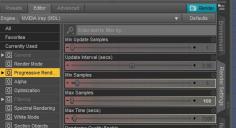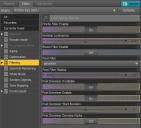My Iray render speed was dramatically increased without hardware update
 RSand55
Posts: 161
RSand55
Posts: 161
Was I the only one not to know about this?
My Windows PC is not the newest and I was always OK with one hour plus renders.
Then I watched a YouTube video about two tweaks: Maximum Samples and Post Denoiser.
The default Max Samples is set to 5000. The vid advises to lower it from 100 to 300 samples
and turn the Post Denoiser ON. After doing that, renders that usually took an hour or more were
done in 10 to 20 % of the time with apparently the same results. My question to my friends here
is there some trade off I'm not seeing? It seems that any savings comes at a price. Your comments
and advice is appreciated. Thank you!


Max Samples 100 to 300.jpg
533 x 289 - 38K


Post Denoiser On.jpg
493 x 448 - 45K


Comments
The denoiser can remove noise, but it can also remove high-frequency detail that you might want. Whether that matters depends on what you are rendering - for example, I had poor results in a library set (distance shelves were smudged) and in the PC/Daz+ 1920s interiors (grills on the heaters were smeared out).
Precisely why I don't use the denoiser. I would love to have quicker renders and I think it may be possible when DAZ catches up with all the latest developments but the denoiser is not an acceptable solution for me at least,
The lower itteration count is the reason it takes less time to render.
The 'tradoffs' are myriad.
The first is increased vram utilization. May be hardware dependent, so check your vram usage to be sure.
This will vary with render size as well, with my tests at 1kx1k only adding ~350MB, and at 4kx4k adding 1.5GB
As richard said, it can cause details to become smudged, this can go as far as the entire image, where it will look too 'soft', or that you smeared vaseline on the lens.
Mirrored, or highly reflective surfaces can also cause some serious weirdness, if there aren't enough samples(iterations) when the denoiser kicks in. see the attached image.
Personally, I find it far too agressive in it's math, and prefer using a post work denoiser such as topaz's, intels, or others, as they give me the control over the results.
I did notice one other 'weird' thing in my testing, the files size is smaller, sometimes by as much as half compared to the non-denoised version.
Reaaly not sure what's going on there.
Yup. I had a feeling there was going to be a cost somewhere. Nothing is free.
I did notice failure at 4000 x 4000 res. In lesser res images not bad. At any rate, it's
fun to experiment. Thanks for the info guys.
That's because to a lossy image compression scheme the 'noise' is basically treated as a detail that the file compression has to spend additional bytes preserving.
For me, the Ai denoiser is a 'god send' for animation renders, but there's no one size fits all, you need to experiment with different iray iteration settings to find the right balance between iray iteration amount and rendering of fine details.
even for non-lossy formats (the attachments were PNG) the more regular data may compress more effectively.